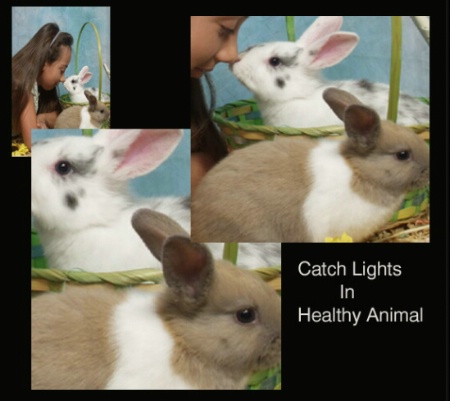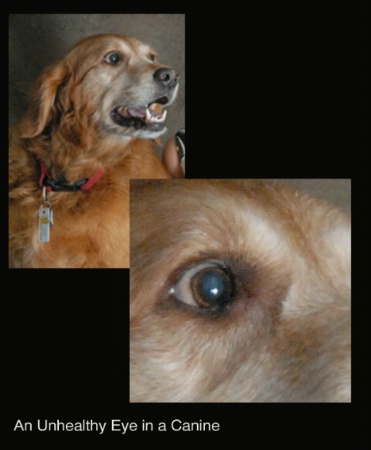
BetterPhoto Member |
|
Photograph Dog
When I photograph my brown eyed dog with a flash his eyes look like aquamarine marbles. How can I avoid this? My best opportunities to photograph are inside.
October 14, 2007
|
|
|
Alan N. Marcus |
|
Hi Doris Red-eye in portraits of humans and the glare you see in the dog’s eye are one in the same. Its cause is the close location of the flash to the lens. Cameras with built-in-flash, by necessary, must position the flash very close to the camera lens due to the size of the camera body. When a flash fires close by to the lens it is said to be “on axis” with the lens. The eyes of humans and animals are structured in such a way that bright light entering the pupil is caused to bounce about inside the shpere of the eye. The structure is such that bright light is caused to exit the eye following a return path directly back towards the originating light source. In the case of humans the light reverberations inside the eye causes the light to take on a reddish hue due to the abundance of blood vessels present in the retina. In the case of animals, the retina is bathed with sensitizing pigments that promote enhanced night vision. Thus the exiting light often appears tinged green-yellow. When eyes encounter a bright light the pupil contracts to a tiny aperture (a protective reflex action). When experiencing flash photography the flash is unexpected and the duration so short the contracting reflex occurs but too late and red-eye often results. The photographer’s countermeasure is to cause the flash to originate from a point some distance from the lens. Many flash units are designed to be dismounted so they can be held at arms length. This act lessens red-eye and the off-axis light is generally very pleasing. Many modern cameras feature a mode know as red-eye reduction. This setting causes the flash to fire a single or sequence of muted flashes timed in advance of the bright picturing taking flash. This action causes the subject’s eye pupil to contract in advance of the open shutter thus reducing the likelihood of red-eye. Taking human and animal portraits in a studio light set-up is best as the lamps are generally not on-axis with the lens. Also, taking picture using available light with the flash turned off prevents red-eye as the light origins are off-axis. Alan Marcus (marginal techno babble)
ammarcus@earthlink.net
s,
October 14, 2007
|
|
|
Debby A. Tabb |
|
|
|
|
|

Catch Lights in a Healthy Animals Eye.
Using a studio set up w/softboxs
Debby A. Tabb
|
|
|
|

Catch Lights in a Unhealthy Eye of a Canine
Using a studio set up w/softboxs
Debby A. Tabb
|
|
|
|
Below is a page from my teaching matierals, with out seeing hte picture your refering to we don't know if your seeing "Red eye" or "catch light"
by your short discription it sounds like "catch light " to me. Catch light
From Wikipedia, the free encyclopedia
Catch light or catchlight is a photography term used to describe either the specular highlight in a subject's eye from a light source, or the light source itself. They are also referred to as eye
A catch light may be an artifact of the lighting method, or have been purposely engineered to add a glint or "spark" to a subject's eye during photography. This technique is useful in both still and motion picture photography. Adding a catch light can help draw attention to the subject's eyes, which may otherwise get lost among other elements in the scene.
Catch light is not the same as the red-eye effect; in general, red-eye is an undesired effect (caused by the reflection of light from the retina inside the back of the eyeball), while catch lights are often aesthetically desirable, and produced by light reflecting from the front surfaces of the eye. Especially in portraiture, eyes without catch lights are often said to appear dull or lifeless. Lighting is often arranged in studio portraits specifically to create attractive catch lights.
As a specific light source, a catch light is usually fairly dim or focused, as to not effect any other part of the scene or face. Many other lighting methods, however, are known for the distinctive or unique catch light they produce. Among those methods are ring lights, which produce several highlights in a ring, and large softboxes, which produce large, square highlights.
While catchlights most often appear to be simply bright spots, as reflections of their surroundings they can contain entire images. Audiences usually perceive eyes without specular highlights to be lifeless or evil, and for this reason many cinematographers specifically eliminate catch lights on antagonistic characters. I do hope this helps,
Debby Tabb
October 14, 2007
|
|
|
|
Log in to respond or ask your own question.
|